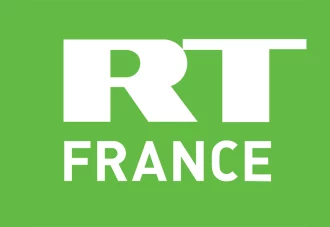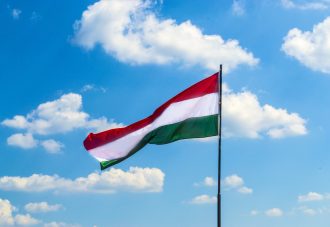In December 2024, Telegram began restricting access to channels belonging to Russian propaganda resources sanctioned by the European Union. We examined how these restrictions currently function within the EU: whether the Telegram channels of sanctioned Russian resources are genuinely blocked for EU users, what methods remain available for circumventing the restrictions within the messenger, and what the overall role of Telegram is in promoting sanctioned Russian content across the EU.
This study is a continuation of our previous work, in which we analyzed how internet service providers in France and Belgium were complying with requirements to block access to RT France, and what methods this sanctioned propaganda resource and its content still used to maintain a presence in the EU information space. At that time, we found that RT France remained accessible to a European audience through the use of alternative domains and mirror sites, the automatic reproduction of its content on aggregator websites, the dissemination of publications via Russian/pro-Russian networks, and quotation by other resources independent of the Russian Federation. This analysis demonstrated that the Russian propaganda infrastructure rapidly adapts to new conditions.
Now, we will examine how similar mechanisms operate within the Telegram environment.
Methodology
1. We compiled a list of Russian propaganda resources that were subjected to EU sanctions during the period 2022–2025.
2. For each of these resources, we collected (if available) links to Telegram channels published on their official websites (i.e., those that the resources themselves position as their official Telegram channels).
3. We verified access to each of these Telegram channels from the territory of the EU, specifically Poland. The testing was conducted using a Polish IP address and local internet service providers’ networks (without the use of a VPN).
4. We searched for Telegram channels with identical or similar names and verified their availability from the same location. This allowed us to identify available alternative channels that openly disseminate sanctioned content without masking it under different names or brands. For this, we used the Google Custom Search Engine (CSE) tool, specifically the CSE managed and maintained by the EU DisinfoLab Research Team.
5.We also analyzed publications in third-party Telegram channels that contained links to sanctioned resources or utilized their content. This enabled us to determine other ways of disseminating sanctioned content on Telegram (such as quoting, reposting, etc.).
All technical data regarding the availability or unavailability of Telegram channels in Poland is provided as of July 2025.
This study does not aim to quantitatively measure the volume of content dissemination. The main focus is on verifying the accessibility of Telegram channels belonging to sanctioned Russian propaganda resources and analyzing the mechanisms by which their content remains in the European information space via Telegram.
The publications included in the sample are considered only as illustrative examples of the mechanisms for disseminating sanctioned content. The purpose of this analysis was not to classify them as disinformation, manipulative, or credible.
Telegram’s Activity in the EU: Prevalence and Regulation
Although Telegram is registered in Dubai, its presence in EU countries automatically subjects the platform to the Digital Services Act (DSA), adopted by the EU in October 2022 and which entered into force across all European Union countries on February 17, 2024. Specifically, Article 13 of the DSA obliges intermediaries like Telegram to have a legal or physical representative in one of the Member States where their services are offered. Providers without their own presence in the EU must officially designate a legal representative.
Under the DSA, “Very Large Online Platforms” (VLOPs) are under the direct supervision of the European Commission and are subject to the strictest rules. This category includes services with over 45 million monthly active users in the EU. Smaller platforms are monitored by national regulators in the Member States where they are registered.
As of August 2025, Telegram has published data indicating that its number of active users in the EU is significantly less than 45 million, meaning the messenger does not fall into the VLOP category. This status was confirmed by the European Commission’s updated lists on June 18, 2025. Thus, Telegram is classified as an “online platform” under the DSA, rather than a “very large one.”
Consequently, in May 2024, Telegram appointed European Digital Services Representative (EDSR) in Brussels as its official representative in the EU. The legal representative for providers of intermediary services ensures effective communication with the competent authorities of the Member States, the European Commission, and the European Board for Digital Services.
In turn, regulatory oversight of Telegram in the EU is carried out by the Belgian telecom authority BIPT, which functions as the Digital Services Coordinator. It is the Belgian authorities who are responsible for monitoring the messenger’s activities and reviewing user complaints from across the EU. BIPT spokesperson Jimmy Smedts commented to Euronews that the regulator’s main task is not to moderate illegal content online, but to control the platforms’ compliance with transparency requirements in this area (specifically, providing users with the ability to report illegal content and informing interested parties about its removal).
According to Telegram, the total number of the messenger’s global users (including those outside the EU) reaches 1 billion. However, the exact number of users in the EU remains unknown, as Telegram limits itself to the rounded data of “less than 45 million.”

Screenshot. Total number of Telegram users (as of March 2025)
In August 2024, the European Commission’s Joint Research Centre (JRC) initiated a technical investigation into Telegram for failing to provide precise user numbers. This relates to Article 24 of the DSA, which mandates internet intermediaries to publish and update data on the average monthly active users in the EU every six months. This requirement is crucial for determining whether a platform belongs to the VLOPs or VLOSEs categories.
Telegram was required to submit current figures but limited itself to the statement that it has “significantly less than 45 million users in the EU.” This contradicts the transparency requirements of the DSA. Should the actual number of users be found to exceed the 45 million threshold, Telegram would automatically be subject to stricter regulatory obligations.
Since official precise information on the number of Telegram users in EU countries is not publicly available, we will present a few arguments as to why the danger of Telegram as a platform for sanctioned Russian content exists regardless of the number of users or channel subscribers.
First, Telegram can serve as a kind of “starting point” for information attacks that are then picked up by users who sympathize with pro-Russian narratives or belong to radicalized or extremist communities. Subsequently, these messages spread across other channels and social networks with a broader audience. As a result, even content with relatively limited initial reach on Telegram can gain a significantly larger scale and viral spread across the broader digital ecosystem.
For instance, research by the European Digital Media Observatory (EDMO) highlights two important observations in this context, using the example of 30 largest far-right and conspiracy-theory Dutch-language Telegram channels. Firstly, communities initially united by anti-vaccination and conspiracy ideas shifted their focus to pro-Russian messaging in 2022, demonstrating thematic flexibility depending on current events. Secondly, Telegram channels act as nodes in a complex disinformation ecosystem: by sharing hyperlinks, they integrate material from various sources, creating cross-platform circulation of fake news and conspiracy theories. “Influencer” and “aggregator” channels direct the audience to other platforms, amplifying the visibility of marginal resources, and the platform itself functions as a hub where disinformation is constantly adapted and disseminated.
Furthermore, studies document a clear trend of how disinformation communities on Telegram, which previously focused on conspiracy or anti-COVID narratives, gradually shifted to spreading pro-Russian propaganda about the war against Ukraine. For example, the Institute for Strategic Dialogue analyzed 225 German-language ultra-right and conspiracy channels and found their high permeability to Russian war narratives. A similar dynamic was recorded by Maldita.es, which showed how the 10 most prominent Spanish-language anti-COVID channels on Telegram transformed into mouthpieces for pro-Russian fakes in the context of the war. EDMO’s analysis of 225 Dutch-language far-right and conspiracy channels also confirmed this narrative shift: anti-vaccination communities adapted to the new conditions and began actively spreading pro-Russian war propaganda.
Secondly, Telegram can function as a transit platform for disseminating the propaganda agenda and, accordingly, be integrated into the architecture of FIMI (Foreign Information Manipulation and Interference) and other information operations. Similar examples are documented in reports by the European External Action Service (EEAS), as well as in a study by The Reckoning Project in cooperation with Global Rights Compliance. The latter traces how Russia uses so-called “information alibis” to plan, execute, and subsequently conceal war crimes in Ukraine, specifically involving Telegram as one of the key channels.

Source: 3rd EEAS Report on Foreign Information Manipulation and Interference Threats
Therefore, regardless of the quantitative indicators of audience size or reach, Telegram occupies a systemic place in the ecosystem of harmful content dissemination, capable of influencing the information environment of EU countries.
Telegram’s Position and Strategy on Countering Disinformation within the Platform
As stated in Telegram’s official explanations: “The most effective way to combat misinformation is to give readers the tools and information to scrutinize the media they consume.” In essence, according to Telegram’s rules, if reliable news agencies, fact-checking organizations, and ministry accounts are registered on the platform, users automatically gain access to credible information.

Screenshot. Telegram’s policy on countering disinformation
Telegram’s argumentation is based on the following premises:
- Dynamic perception of social and scientific issues. What seems implausible or ridiculous today may become a generally accepted point of view tomorrow, and an outdated notion the day after.
- Platform neutrality. Telegram does not see its role as deciding for users what they should believe.
- Effectiveness of countering disinformation through censorship. Conspiracy theories are often only reinforced after their content is removed by moderators. Instead of eliminating misconceptions, censorship can complicate the fight against them. Therefore, disseminating reliable information is a more effective strategy.
Furthermore, Telegram is not a signatory to the enhanced Code of Practice on Disinformation, a voluntary framework developed to combat disinformation risks. The Code was first established in 2018 with the participation of a wide range of stakeholders—online platforms, search engines, the advertising industry, fact-checking organizations, and civil society representatives. In 2022, it was significantly reinforced so that it could gain the status of a Code of Conduct within the framework of the DSA. On February 13, 2025, the European Commission and the European Board for Digital Services officially approved the Code’s integration into the DSA. From July 1, 2025, its obligations became auditable, and the Code serves as an important reference for assessing the compliance of platforms with VLOP/VLOSE status (which, we recall, Telegram does not have) with the DSA requirements regarding disinformation risks.
The Code covers several interconnected areas that help effectively counter disinformation risks while preserving freedom of speech and increasing transparency: demonetization; transparency of political advertising (introduction of effective labeling); combating fake accounts, bot networks, manipulative deepfakes, and other mechanisms for disseminating disinformation; and strengthening the capacity of users, researchers, and fact-checkers in the context of identifying and analyzing disinformation.
Since Telegram has not joined the Code, none of its provisions actually affect the platform’s policy on disinformation. Combined with the absence of specific mentions in the terms of service prohibiting false content, this means that users do not have a specific mechanism for reporting disinformation, and the platform decides for itself how, and whether, to respond to the spread of fakes. Thus, the fight against disinformation on Telegram remains entirely at the service’s discretion without external supervision or audit.
Currently, according to the User guidance for the EU Digital Services Act, the following types of content and activities are prohibited on the Telegram platform: spreading spam; calls for violence, terrorism, or fundraising in support of terrorist organizations; publishing illegal sexual content; activities deemed unlawful in most countries, including child abuse, the sale or offer of prohibited goods and services (drugs, weapons, forged documents), and the dissemination of personal data for the purpose of intimidating or harassing other users.
However, it should be noted that in the context of our study and the case of sanctioned Russian resources, Telegram is no longer dealing with the assessment of content truthfulness. This concerns resources and content prohibited within the EU, which is a separate category from traditional disinformation. Moreover, in the case of Russian state resources, it is not about “choosing what to believe,” but about the use of Telegram as a tool and platform by governments for FIMI, conducting psychological and informational operations with the aim of undermining democracies from within the EU through influence on public opinion.
EU Sanctions Against Russian Propaganda Resources
In response to Russia’s full-scale invasion of Ukraine, the European Union began imposing sanctions against a number of state-backed Russian propaganda resources. The sanctions became part of the EU’s efforts to combat the disinformation and propaganda used by Russia to justify the war against Ukraine, influence public opinion in the EU, and destabilize the EU and its Member States.
Currently, the EU has suspended the broadcasting and revoked the licenses of 27 Kremlin-backed propaganda resources used for the deliberate dissemination of propaganda and the conduct of disinformation campaigns, including within the EU territory. The restrictions apply to all means of transmission and distribution of information: cable and satellite television, internet platforms, websites, and applications.
In total, to date (August 2025), sanctions have been implemented against the following Russian propaganda resources:

The analysis of the expansion of the sanctions list against Russian propaganda resources in the period from March 2022 to February 2025 demonstrates a critical trend: the growing awareness of the danger of Russian propaganda and its influence on the citizens of the European Union.
Initially, sanctions targeted the most well-known state resources focused on international audiences, such as RT and Sputnik. The list was later broadened to include Kremlin-affiliated resources, such as the Strategic Culture Foundation (SCF), which, according to the East StratCom Task Force, masks its Russian affiliation by presenting itself as an independent English-language resource. Subsequently, platforms used for implementing “soft power” were added to the sanctions, specifically the online journal New Eastern Outlook, published by the Institute of Oriental Studies of the Russian Academy of Sciences, as well as channels associated with the Russian Orthodox Church, including the SPAS TV channel.
This gradual expansion of sanctions indicates a shift in the EU’s approach—moving from reacting to obvious sources of propaganda to systemically blocking a network of secondary platforms that retransmit Kremlin messages. This allows for more effective countermeasures against Russian information influence and underscores the need to move away from point-based bans towards the comprehensive blocking of the disinformation dissemination infrastructure.
Thus, in January 2025, the European Parliament adopted a resolution titled “Russia’s disinformation and historical falsification to justify its war of aggression against Ukraine,” in which it condemned Russia’s use of disinformation to justify the war against Ukraine and called on the EU to expand sanctions against Russian propaganda resources that spread such disinformation. The European Parliament urged the EU and its Member States to further strengthen and better coordinate their efforts to counter Russian disinformation and foreign interference.
However, according to the European External Action Service (EEAS) in the field of disinformation and foreign interference, the main channels of dissemination are not only state information resources but also official diplomatic channels, pro-Kremlin online platforms that conceal their connection to the Russian government, and those that may be financed from Moscow.
This indicates that while sanctions limit the official broadcasting of propaganda resources within the EU, they do not eliminate all disinformation threats. Russian propagandists are adapting by using social media, messengers, and other less regulated digital platforms.
Telegram Channels of Russian State Propaganda Resources and the Role of Telegram in Evading EU Sanctions
Russian state propaganda resources demonstrated readiness for possible sanctions and restrictions on their activities even before the start of Russia’s full-scale invasion of Ukraine. They began searching for alternative channels early on to retain their audience, disseminate content, and build entire networks for this purpose. For example, NewsGuard identified Russia’s use of so-called “sleeper sites” technology aimed at foreign audiences. These resources were created before February 2022, gradually gained popularity through neutral, harmless publications, and concealed their connection to the Russian government, but at a designated moment, they switched to spreading propaganda and false narratives.
Another important tool for disseminating propaganda became Telegram. At the time, the lack of content moderation turned the platform into a kind of “safe haven” for Russian propaganda.
The first wave of migration and increased activity of Russian propaganda resources on Telegram can be traced back to 2021. This was linked both to the strengthening of internal policies regarding Russian resources within individual EU countries and to the moderation policies on other platforms like X (Twitter), Facebook, YouTube, and others. It was then that these platforms began actively labeling or restricting the dissemination of disinformation content, including that from Russian state resources.
As early as March 2020, German special services, the Federal Office for the Protection of the Constitution (BfV) and the Federal Criminal Police Office (BKA), began monitoring RT Deutsch due to the specifics of its coverage of the COVID-19 pandemic.
In June of the same year, the National Electronic Mass Media Council of Latvia (NEPLP) banned the broadcasting of seven RT channels (RT, RT HD, RT Arabic, RT Spanish, RT Documentary HD, RT Documentary, RT TV). The regulator explained the decision by stating that the channels were under the effective control of Dmitry Kiselyov, who is on the EU sanctions list for undermining the territorial integrity and sovereignty of Ukraine.
A month later, a similar decision was adopted by the Lithuanian Radio and Television Commission (LRTK), which banned five RT channels following recommendations from the Lithuanian Ministry of Foreign Affairs.
From February 1, 2022, the German Commission for Licensing and Supervision (ZAK) prohibited the broadcasting of any RT DE programs in the country due to the lack of a national license, which is mandatory under German law.
Earlier, Margarita Simonyan, the editor-in-chief of RT, called this a “media war declared by Germany on Russia”.

And already in February 2022, the Russian Foreign Ministry published measures targeting Deutsche Welle (DW) in response to Germany’s ban on satellite and online broadcasting of the RT DE television channel. Specifically, these measures included the closure of the DW correspondent office in Moscow, the cessation of satellite and all other broadcasting of the German media company on Russian territory, the revocation of accreditation for DW’s Russian bureau employees, the recognition of DW as a “foreign agent,” and a ban on entry into Russia for those whom the Russian Federation deemed involved in “restricting RT DE broadcasting.”

Screenshot. Russia’s corresponding measures against Deutsche Welle due to the ban on satellite and online broadcasts of RT DE in Germany
During this period, social platforms also began implementing additional restrictions. For instance, Meta introduced the “state-controlled media” label, which appeared on publications by Russian state resources; users saw the message: “This publisher is controlled by the state of Russia.”
In 2021, YouTube permanently removed three German-language channels belonging to the state TV channel RT—RT DE, Der Fehlende Part (DFP), and RT auf Sendung—without the possibility of reinstatement. According to the Google press service, the RT DE channel was removed for spreading false information about COVID-19, and the subsequent two were removed for attempting to bypass the block. The video host also removed one of the largest Crimean channels, “Krym 24,” and temporarily (for one day) restricted the functionality of the “Vesti Krym” channel, prohibiting new video uploads and live streams, and blocked Ukrainian users from viewing the TV channels of Viktor Medvedchuk (“112 Ukraina,” “Newsone,” “ZIK”). Furthermore, YouTube blocked the propaganda film “Crimea. The Way Home” due to scenes of violence present in the material. (The video later reappeared in a re-uploaded version, but the fact of the block at that time was significant.)
In response, Russian media began claiming “censorship” and “infringement of freedom of speech,” but at the same time, they actively migrated their subscribers to Telegram, which was becoming a “safer haven” for them.
As early as 2021, EUvsDisinfo recorded how Sputnik and RT were expanding their presence on Telegram. At that time, the various language desks of these resources created more than 30 channels, some of which began operating in late 2020. Throughout 2021, the channels of Sputnik International, Sputnik Italia, RT France, and Sputnik France joined them.
Concurrently, Sputnik and RT launched a large-scale cross-platform campaign to promote their Telegram channels. According to EUvsDisinfo, RT International published 2,600 tweets calling on users to join their Telegram channel in just six months. In total, different RT and Sputnik desks posted over 9,000 posts on Facebook with similar links and invitations. These messages were reinforced with banners, interactive buttons, and blocks on official websites.
The result of this systematic work was a significant expansion of the audience for Russian state media on Telegram before the start of Russia’s full-scale invasion of Ukraine.
The second wave of activity by Russian propaganda resources on Telegram was recorded in early 2022. This wave focused not only on maintaining presence but also on attracting a broader audience. The impetus for this wave was the first EU sanctions imposed against RT and Sputnik.
It is important to emphasize that sanctions restrictions also affected other platforms—the pages of Russian media on Facebook and YouTube were partially blocked or removed. While Meta’s initial restrictions on page access applied only to Ukraine and the EU, they later became global (in 2024, Meta completely banned the RT media group and other related organizations on its platforms (Facebook, Instagram, WhatsApp, and Threads) worldwide for foreign interference).
This signaled to the Kremlin a loss of control over audiences through platforms not under Russia’s control (including foreign television broadcasting). For the domestic user, homemade prototypes of popular social networks—RuTube, Rossgram, etc.—began to be created or promoted. This aimed not only to retain control over their own audience but also to limit their access to foreign content undesirable to the Kremlin (through institutions like Roskomnadzor). Simultaneously, for the audience in the EU, it was necessary to search for alternative channels for propaganda dissemination. Telegram became one of the key tools for this.
A 2022 report by the Institute for Strategic Dialogue (ISD) analyzed the tactics adopted by Russian media in response to the suspension of RT France and Sputnik France.
Specifically, the ISD documented that before the ban, the Twitter accounts of RT and Sputnik France actively advertised their Telegram channels. This is confirmed by the fact that from January 1 to February 28, 2022, the word “Telegram” was the most frequently used word in the posts of these accounts.

Source: Report “Implementation and Impact of the RT and Sputnik Ban on French Online Ecosystems”, Institute for Strategic Dialogue
In addition, after the start of Russia’s full-scale invasion, the French editorial office of Sputnik announced the blocking of its YouTube, Facebook, and Instagram accounts and urged its audience to switch to Telegram. Following the EU’s sanctions decision on March 4, Sputnik France completely ceased operating its website and social media, leaving only its Telegram channel. The channel was renamed “Fil à Retordre” (literally “Hard Time” or “Something Complicated to Deal With”) to avoid blocking in France. However, content was published until March 17, after which the channel was closed.
In May 2022, Sputnik France was officially declared bankrupt and liquidated, and it was relaunched in the French-speaking segment as Sputnik Afrique.
At the same time, according to ISD data, marginal online communities on Telegram circulated screenshots of materials published by RT France and general instructions for using VPNs, as well as links to specific services.
This is also confirmed by an EDMO study based on the example of the Baltic countries, which states that after the ban on Kremlin television and online propaganda, the niche for disseminating Russian propaganda was filled by social networks, with Telegram standing out in particular. The study notes that while the most popular channels in the Baltic countries, targeting local Russian speakers, do not have a large number of subscribers, their main role is to amplify each other’s content and create the impression that many people think the same way.
Thus, Telegram became a key tool for the “rescue” of Russian propaganda resources from sanctions at the initial stage of their implementation. It was on Telegram that new content dissemination ecosystems began to form, which continue to operate even after the sanctions.
Blocking of Telegram Channels Belonging to Sanctioned Russian Propaganda Resources in the EU
On December 28, 2024, Russian resources, including RIA Novosti, began reporting the blocking of their Telegram channels in EU countries.

Screenshot. RIA Novosti message about the blocking of its Telegram channel in the EU
During the same period, while in France and Belgium, we also recorded restrictions on access to the official channels of RT and Sputnik, as confirmed by the screenshots below.

Screenshot. Access restrictions to RT and Sputnik Telegram channels in France and Belgium
On December 31, 2024, Telegram officially confirmed the blocking of access to a number of Russian state resources for EU users. The company’s statement noted that these restrictions were introduced to comply with the requirements of the Digital Services Act (DSA) and to execute EU sanctions decisions.
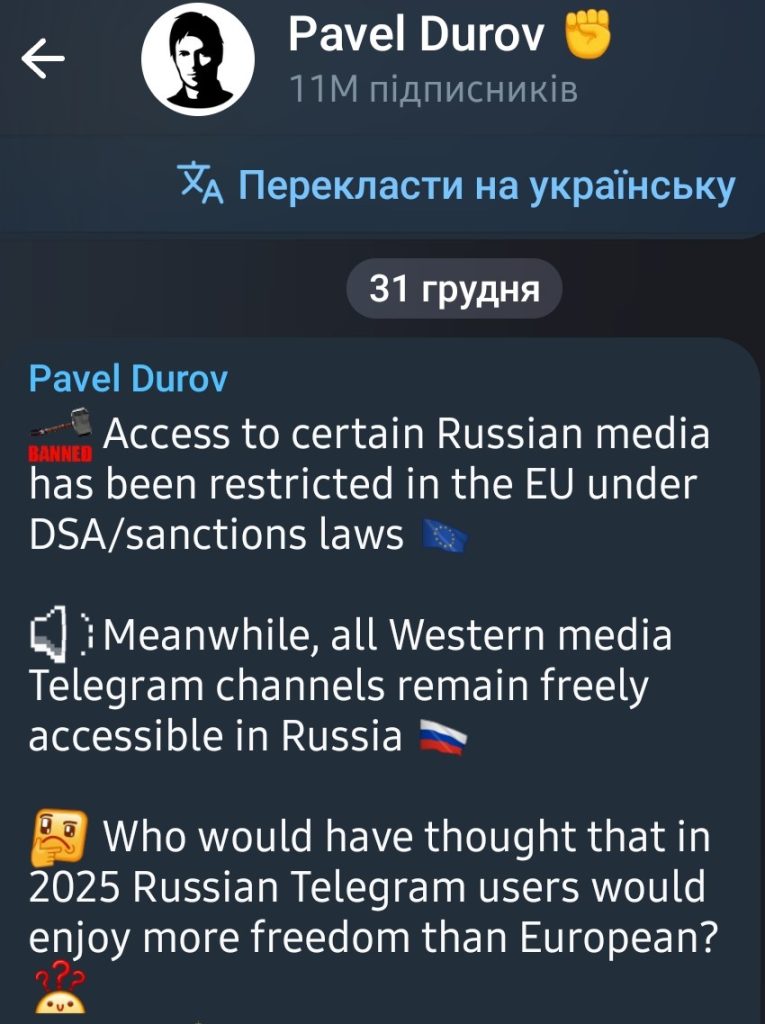
Screenshot. Pavel Durov’s reaction to the blocking of Telegram channels of sanctioned Russian propaganda resources in the EU
One of the key goals of the EU’s sanctions regime against Russian entities is to disrupt the Kremlin’s systematic international campaign of disinformation, information manipulation, and election interference aimed at destabilizing neighboring countries and EU Member States. To achieve this goal, the EU included a number of media organizations and individuals deemed involved in propaganda activities on the sanctions list.
In May 2024, the European Commission clarified that any broadcasting of content by sanctioned media or individuals falls under the sanctions. Even the free dissemination of such content creates recognition, allows the promotion of products, generates advertising revenue, and influences the audience, and is therefore considered the provision of an “economic resource” to sanctioned entities, which is directly prohibited.
By allowing these resources to operate, Telegram essentially facilitates their economic gain and thus may be violating sanction provisions.
According to a report by Alliance4Europe and Science Feedback, on certain platforms, economic gains for these entities are created even through advertising revenue or monetization programs, which can effectively be viewed as direct financing of sanctioned structures.
The European Commission further clarified that the sanctions prohibit the hosting of content by these individuals or organizations or making it accessible to the EU audience through content-sharing platforms or search engines. In practice, this means that the restrictions apply not only to the official accounts of sanctioned media and individuals but also to “mirror” channels, relay channels, and other forms of content dissemination—from the indexing of “mirror” sites and the publication of instructions for circumventing blocks to the hosting of RT documentaries in cloud storage or official channels on WhatsApp.
In addition to sanctions legislation, the DSA plays an important role, as it obliges platforms to promptly remove or block access to illegal content upon receiving information about its dissemination (Articles 34 and 35). In fact, the hosting of content by these sanctioned entities is illegal. Despite the fact that sanctions lists are formed at the EU level, control over their implementation rests with national competent authorities. In the case of Telegram, which has its legal representative in Belgium, these functions are performed by the relevant Belgian structures.
However, the Russian Ministry of Foreign Affairs (MFA) considered the blocking of Russian resource Telegram channels in EU countries as further evidence of the “West’s course toward suppressing dissent” and a “violation of international obligations in the field of freedom of speech.” Official representative Maria Zakharova stated that Russia reserves the right to “symmetrical retaliatory measures.”

Screenshot. Russian MFA reaction to the blocking of Russian propaganda resource Telegram channels in the EU
Pavel Durov also criticized these restrictions in the EU, emphasizing what he calls “greater freedom for Russian users” compared to Europeans.
Despite this, a study by the Alliance for Securing Democracy (German Marshall Fund of the United States), published in June 2025, revealed three main trends in circumventing blocks on Telegram. Specifically, more accounts duplicating the official channels of RT and Sputnik were found on this messenger than on any other platform. Some of them are blocked in the EU, but others remain accessible, such as an English-language channel with compilations of RT and Sputnik news.
Additionally, some Telegram channels contained a link that automatically allows users to join alternative RT or Sputnik Telegram channels without the need to manually search for and add them. Such links were found for English- and German-language content.
Furthermore, the Alliance for Securing Democracy (ASD) recorded that RT Arabic journalists actively run their own channels: at least 34 accounts belonging to individual journalists continue to disseminate RT Arabic materials. Although the official RT Arabic channel is blocked in the EU, users can subscribe to the personal channels of journalists who regularly share RT Arabic content.
Earlier, in September 2024, an Alliance4Europe report testified that the EU audience had access to 26 official Telegram channels of Russian media sanctioned in the EU, or channels impersonating them. All of them remained active, with a reach ranging from a few thousand to several million subscribers. The same report identified 11 personal channels of media figures included in the EU sanctions list (Annex I of Council Regulation No 269/2014).
A second Alliance4Europe report, prepared in December 2024 (a few weeks before the blocks began), identified several more mechanisms for disseminating sanctioned Russian content on Telegram. Specifically, RT propagandists frequently re-publish materials from their channels, and individual accounts systematically spread content from sanctioned media, using it to promote illegal paid IPTV services that provide access to sanctioned channels.
Another scheme combines YouTube and Telegram: sanctioned Russian channels create one-time YouTube accounts for live streams. These accounts are quickly blocked but are immediately replaced by new ones so that broadcasts do not stop. The goal of this strategy is to minimize broadcast interruptions and circumvent platform rules. Coordination takes place via Telegram (for example, using the “Restream” service), which is accessible in the EU. Telegram is used as a control center: new links to live streams are regularly published there, their accessibility is ensured, and a large library of video materials is maintained.
According to updated data from Alliance4Europe, immediately after the blocks began, it was recorded that about 80% of Telegram channels related to Russian propaganda resources under EU sanctions continue to be accessible in EU countries. Furthermore, Telegram channels controlled by individuals and companies on the sanctions lists, including those held responsible for spreading disinformation and propaganda, also remain fully accessible to users in the EU.
All of this creates an opportunity for sanctioned Russian propaganda resources to circumvent restrictions, continuing to influence the European information space and manipulate the opinions of the population in Europe.
Research Results: Blocking Access to Telegram Channels in the EU
In total, we investigated:
- 27 official Telegram channels, the links to which are directly placed on the respective resource websites;
- 41 additional Telegram channels, representing separate sections of sanctioned resources, specific products of these resources (e.g., Telegram channels of individual TV programs), as well as channels targeting specific regions or languages, or those with identical names and similar content.
The verification of the accessibility of the official Telegram channels of sanctioned Russian propaganda resources (those with links placed on their official websites) showed that a number of these channels cannot be opened from the territory of Poland using Polish IP addresses and local provider networks, without the use of a VPN.

Screenshot of the message displayed when attempting to access blocked Telegram channels of sanctioned Russian resources (Poland, July 2025)
As a result of the study, it was established that:
- Telegram channels of 16 sanctioned resources are blocked from the territory of the EU (specifically, from the territory of Poland). This means that at least one Telegram channel of the resource is blocked (such as RT, which has a large number of various channels—more details on this in the next sub-section)
These resources include a number of channels from the RT group, Sputnik, the VGTRK media holding (including ROSSIYA 24, ROSSIYA 1), as well as other sanctioned Russian resources—RIA Novosti, Pervyy Kanal (Channel One), Rossiyskaya Gazeta, Izvestiya, REN TV, NTV, News Front, Katehon, New Eastern Outlook, Tsargrad TV, Oriental Review.
- Telegram channels of 9 sanctioned Russian resources remain accessible without technical restrictions. Among them are TV Centre International, Spas TV Channel, EADaily (Eurasia Daily), Fondsk, Lenta, RuBaltic, SouthFront, Strategic Culture Foundation, “Krasnaya Zvezda”/TV “Zvezda”.
- For two resources (Voice of Europe (the site does not open technically, and we did not find active Telegram channels as of 2025), Rossiya RTR / RTR Planeta), we were unable to find official links to Telegram channels.
The detailed verification results are presented below (see Table 2). The list includes only those resources for which corresponding Telegram channels were successfully found.

For comparison, in studies by Science Feedback and Alliance4Europe as of September 2024 and December 2024 (pp. 27-28 and pp. 42-44), all Telegram channels from the sanctioned list of Russian resources were accessible. The study by the Alliance for Securing Democracy (ASD) as of June 2025 details access to RT and Sputnik, where the researchers already identify Telegram channels that are blocked in the EU.
Thus, the results obtained indicate that Telegram is indeed applying regional access restrictions to the official Telegram channels of sanctioned Russian resources. At the same time, some channels remain open, which creates a significant loophole for circumventing sanctions and disseminating sanctioned content among the European audience. Moreover, as subsequent stages of the study show, these restrictions do not fully prevent the spread of sanctioned content in the EU information space.
Research Results: Methods of Circumventing Restrictions
Method №1. Selective Blocking
Description: For Russian resources that operate multiple Telegram channels, some channels belonging to the sanctioned resources are blocked, while others are not.
The method of selective blocking allows us to identify several gaps in restricting access to sanctioned Russian resources.
Firstly, Telegram channels of a portion of the sanctioned resources remain accessible. For example: EADaily (Eurasia Daily), Lenta.ru, SouthFront, and others (see Table 2).
The failure to block access to official Telegram resources poses further threats to the information security of European countries. A characteristic example is the Spas TV Channel/СПАС, a tool of Russian soft power, the federal Russian TV channel of the Russian Orthodox Church. As a reminder, the resolution “Propaganda and freedom of information in Europe,” adopted on October 1, 2024, by the Parliamentary Assembly of the Council of Europe, emphasized the recognition of the Russian Orthodox Church as a propaganda mouthpiece for the Kremlin. The Assembly underscores that for authoritarian regimes, including Russia, propaganda is an integral part of the war against democracy. The document points to the need for effective and coordinated action to combat this phenomenon.
Secondly, in cases where a resource has multiple language versions of Telegram channels, the blocking is inconsistent: some channels are restricted, while others remain accessible.
For example, the resource New Eastern Outlook, published by the Institute of Oriental Studies of the Russian Academy of Sciences. The main channel is blocked, but the French-language version, New Eastern Outlook FR, is still accessible. A similar situation is observed with the sanctioned resource Katehon: the English-language channel is blocked, but the French-language one (Katehon en français) operates without restrictions.
Strategic Culture Foundation (SCF) has built an entire network of foreign-language Telegram resources following the same principle.
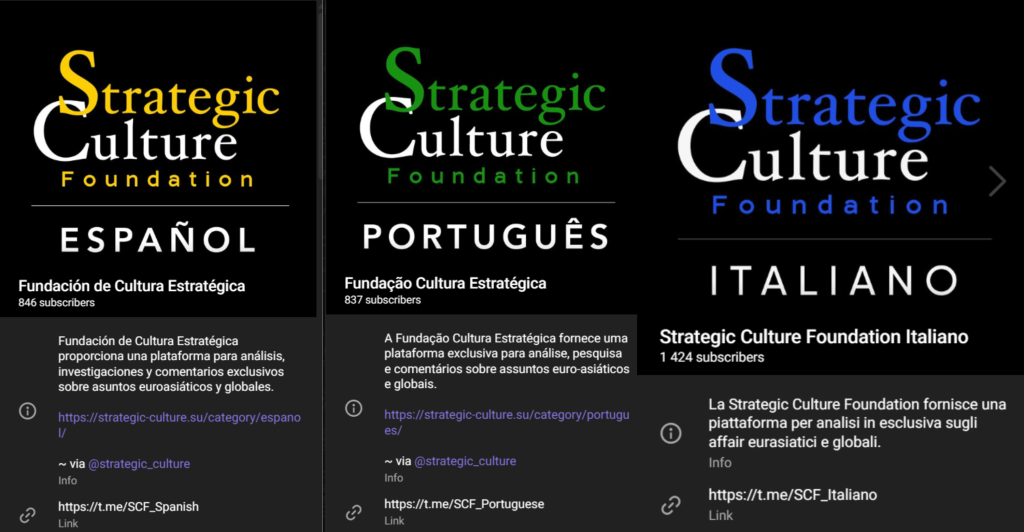
Strategic Culture Foundation Network
In addition, content from sanctioned Russian resources (particularly RT), which may even be restricted or blocked within Telegram itself, is duplicated and disseminated through the unblocked channels of the Strategic Culture Foundation network.

Screenshot of an example of RT content distribution through an accessible French-language Strategic Culture Foundation Telegram channel
Another example of regional Telegram channels is Sputnik. Despite the fact that 8 Telegram channels (which we identified) are blocked, a number of other regional Sputnik Telegram channels remain accessible on Telegram, such as: Sputnik Lithuania, Sputnik Moldova, Sputnik Česká Republika.
The case of Sputnik Afrique warrants separate consideration. We previously noted that Sputnik Afrique was created as a French-language Sputnik resource after the closure of Sputnik France, targeting Francophone countries in Africa. In the context of the blocking of Telegram channels, we see that Sputnik Afrique Officiel is blocked, yet its English-language version, Sputnik Africa, and its Amharic-language version, Sputnik Ethiopia, are still available for viewing.
Thirdly, one resource can have multiple Telegram channels segmented by sections/topics, which also complicates blocking. This creates a multiplicity of such channels, and the names of these Telegram channels may not directly correspond to the name of the sanctioned resource (but instead carry the name of a program broadcast on that same resource—and therefore contain sanctioned content).
For example, although the main RIA Novosti Telegram channel is blocked from viewing in the EU, this sanctioned resource has many Telegram channels divided by thematic sections or regions. Thus, “RIA Novosti Crimea,” “RIA Novosti in English,” and “RIA Novosti Sport” still remain accessible.
The same situation is true for NTV, where the official Telegram channel is blocked, yet the “NTV Entertainment” Telegram channel and the Telegram channel of one of NTV’s programs, “Weekly Summary with Vladimir Chernyshov,” remain accessible.
REN TV has two official channels marked with a blue checkmark. However, only one of them is blocked from viewing within the EU—”REN TV | TV Channel”—while “REN TV | News” is still accessible.
Similarly, despite blocked Telegram channels, RT still has a number of available, related Telegram channels, such as:
- Propaganda schools: “RT School”;
- Propaganda products: “RT.DOC FESTIVAL: TIME OF HEROES,” “RT.doc | Documentary Cinema”;
- Regional Telegram channels: “RT – Egypt,” “RT Brasil”;
- Alternative Telegram channels: “RT-DE Livestream mit Nachrichtenarchiv” (Translation from German: “RT-DE Livestream with News Archive”)—a channel that contains automatic recordings of all news in video and audio format.
In the case of the Lenta.ru Telegram channels, it is important to note not only the variability of channels by section but also the variability in strategies and content delivery formats. We should note beforehand that none of these channels are blocked from viewing for EU users.
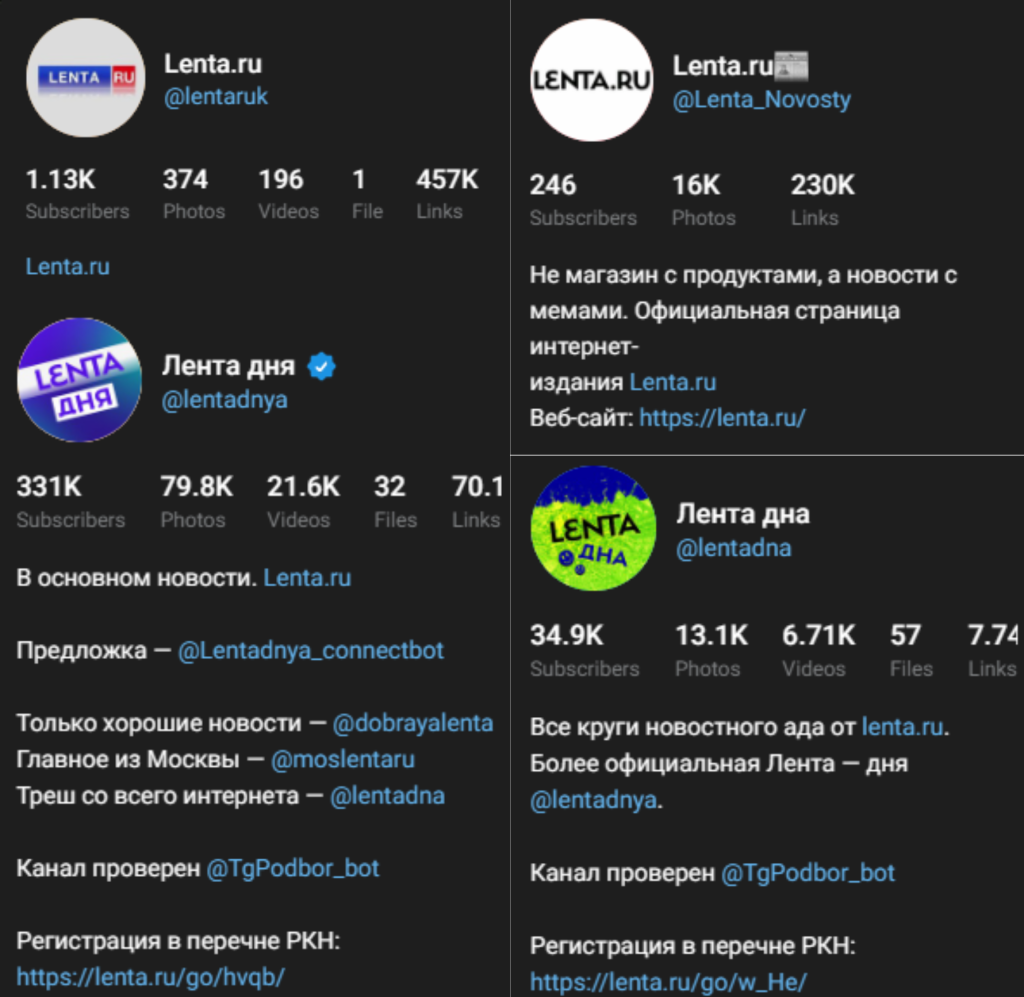
Examples of the Variability of Telegram Channels of the Sanctioned Russian Resource “Lenta.ru”
The Telegram channel “Лента дня” does not contain direct hyperlinks but publishes content identical to the website. The channel “Lenta.ru” functions as an event overview and contains a continuous set of links to the sanctioned resource. Another example is the channel “Лента дна”, which differs from the previous ones and is a selection of “curious” news, random videos, and entertainment content.
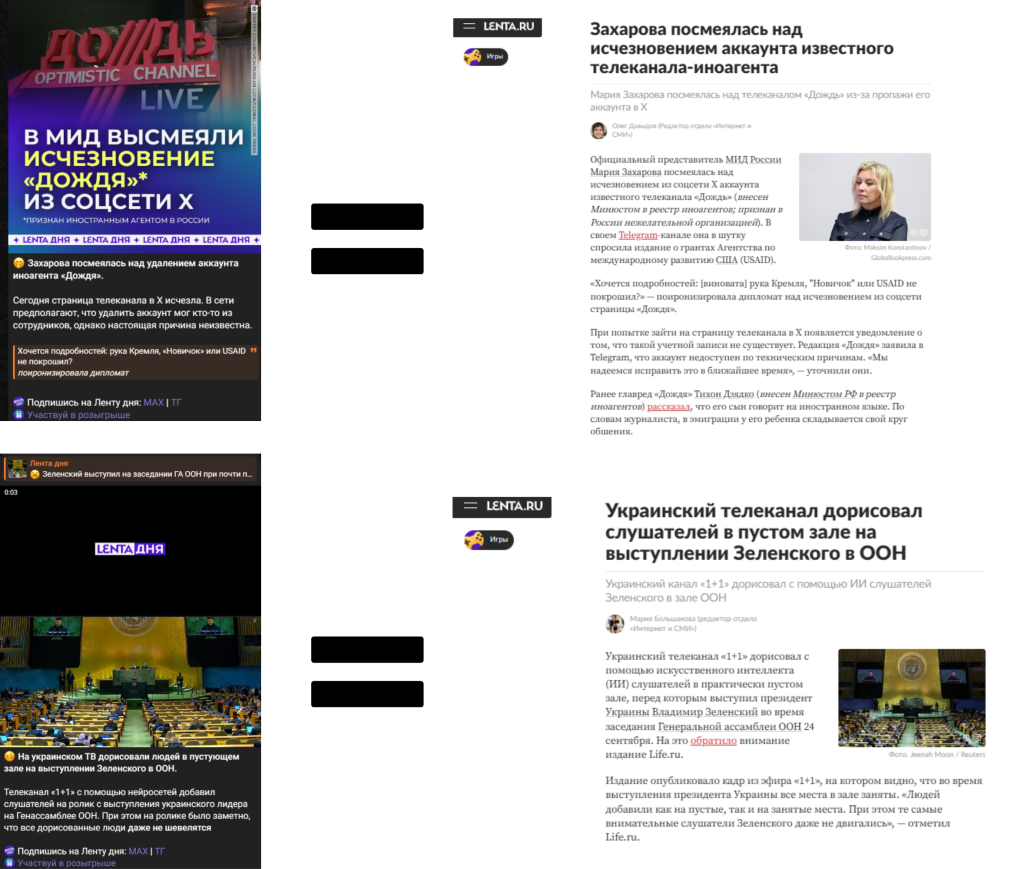
Examples of rebroadcasting of Lenta.ru content

Examples of Content Dissemination in the Lenta.ru Telegram Channel
Another Telegram channel called “Lenta.ru” is most likely operating in a fully automated mode. In fact, the content that appears on the website is automatically relayed to the Telegram channel—the title and the link. And this happens every minute. Such “minute-by-minute” publication is unlikely to be the manual work of an editor—most likely, the channel is technically connected to the RSS feed or the site’s internal API.

Examples of content dissemination in the Lenta.ru Telegram channel
Such inconsistency in the application of sanctions (leaving separate language versions, regional or section-based channels, as well as media-related sanctioned projects accessible) allows Russian propaganda to continue disseminating content among the European audience.
Method №2. Non-Identical Telegram Channel Names
Description: Channels are masked under different names but actually belong to sanctioned resources.
This method is misleading regarding the affiliation of the Telegram channel to a specific resource. This only becomes clear from the channel description, which contains a hyperlink to the main website of the sanctioned Russian resource.
For example, the RuBaltic Telegram channel currently operates under the name “Балтология” (Baltology), and News Front operates under the name “FRONTовые Zаметки” (Frontline Notes). However, the FRONTовые Zаметки channel is already blocked on Telegram for users from EU countries. As for “Балтология,” its official status as a channel of the RuBaltic resource is confirmed by the presence of mutual links: the channel description contains a link to the RuBaltic website, and the website itself has a hyperlink to this Telegram channel.
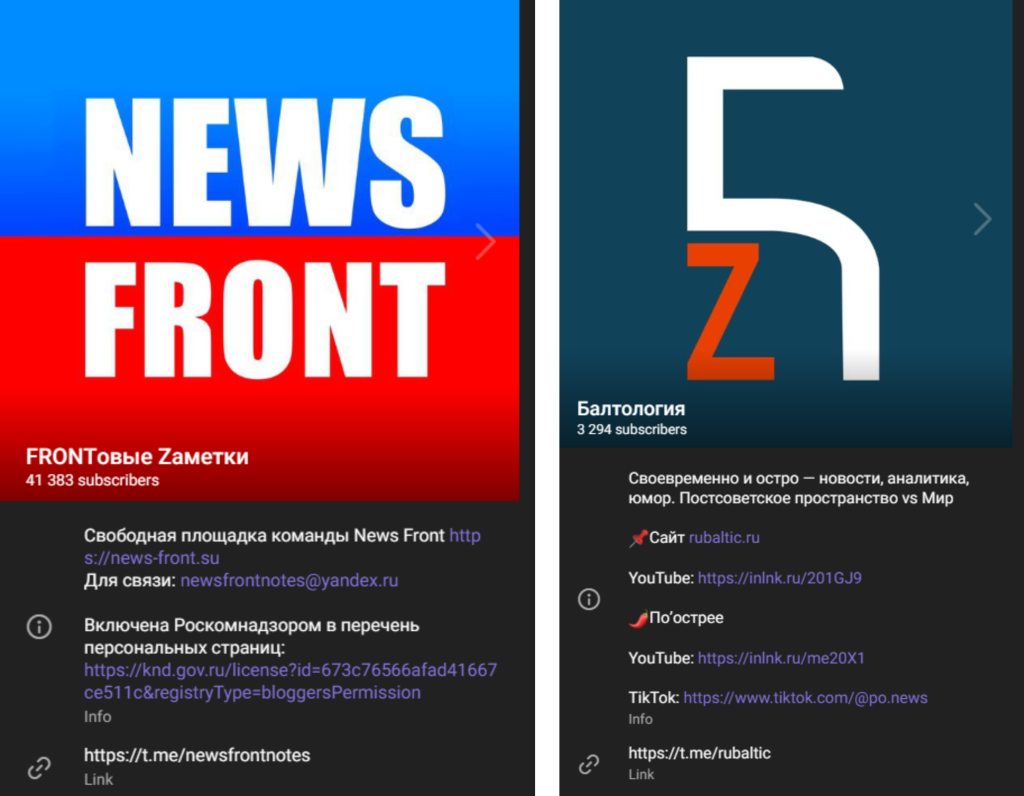
Example of the mismatch between Telegram channel names and the names of their official Russian Federation resources
Thus, the masking of sanctioned channels under other names complicates their identification and allows for the continued dissemination of prohibited content. Visually, the channel is not associated with the propaganda resource, but it remains its de facto component.
Method №3. Alternative Telegram Channels
Description: Creation of supplementary Telegram channels and copies of official channels.
One of the key tactics for disseminating disinformation content is the creation of alternative or duplicate Telegram channels. The same resource may maintain its “unofficial” copies, which allows for expanding reach and circumventing restrictions.
According to the Alliance for Securing Democracy study, the largest number of accounts that fully or partially copy the content of the official RT and Sputnik channels were recorded precisely on Telegram—more than on any other platform. Some of them are blocked in the EU, but others remain active and accessible to users. For example, an English-language channel with news compilations from RT and Sputnik is operational, while RT France content is periodically retransmitted in a number of unofficial channels.
Characteristically, the identified alternative channels have no access restrictions, which ensures their stable presence and influence on the audience.
As an example of creating such supplementary Telegram channels, we can cite the practice of RT. We found a parallel channel with an identical name and image, as well as synchronized publication times. The only difference lies in the selectivity of the content—not all posts are duplicated, only selected ones.

Example of Identical Telegram Channels “RT in Russian”
Furthermore, RT also resorts to combined Telegram channels for news from RT and Sputnik simultaneously. This channel is unblocked and disseminates content, including propaganda video reports from RT and Sputnik.

Screenshot. Telegram Channel “RT and Sputnik”
The existence of two Strategic Culture Foundation (SCF) channels with identical descriptions, where one is labeled “official” and the other “unofficial,” is also revealing. Importantly, the “unofficial” channel not only retransmits materials from the website but also advertises other propaganda Telegram channels in its description. The identical sets of links in their descriptions testify to the belonging of these resources to a single propaganda dissemination system.
For example, one of them leads to the Telegram page of Swiss Policy Research (SPR), a resource that positions itself as a “center for propaganda research” but is actually criticized for spreading conspiracy theories and various speculations related to the COVID-19 pandemic. The German public broadcasting news service Tagesschau refers to SPR as a propaganda tool.
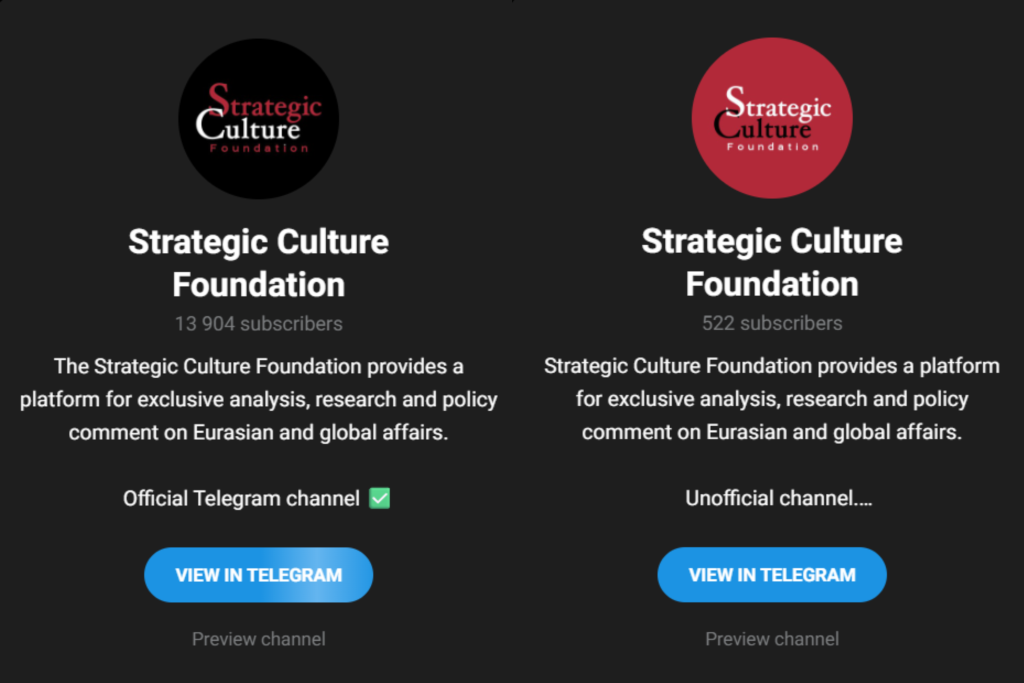
Examples of Strategic Culture Foundation Telegram Channels (Official/Unofficial)
The creation of alternative and duplicate Telegram channels allows Russian state resources to maintain their presence on Telegram despite the blocking of their main channels.
Method №4. Telegram Channels of Propagandists and Representatives of Russian Soft Power Institutions
Description: Representatives of sanctioned Russian resources (propagandists, founders, and others) retransmit prohibited content on their personal Telegram channels.
An example of this method of circumventing restrictions on Telegram is Katehon (a publication of the Tsargrad Institute, headed by Alexander Dugin). The website katehon.com is used for publishing “materials from seminars, congresses, and conferences of the Institute, as well as scientific reports and studies.”
Despite the blocking of the English-language Telegram channel, other channels associated with representatives of the Tsargrad Institute continue to function and remain an additional platform for disseminating propaganda content on Telegram.

Screenshot of Katehon content dissemination through Alexander Dugin’s Telegram channel
The example with RIA Novosti is also illustrative: the agency’s official Telegram channel is blocked, but the channel run by representatives of the Kremlin pool of journalists—RIAKremlinPool—remains publicly accessible. It has a significant reach—about 74,000 subscribers.
Thus, even with the blocking of official channels, representatives of Russian propaganda and “soft power” resources use personal or affiliated Telegram channels to disseminate prohibited content, ensuring continuous audience reach and bypassing sanction restrictions.
Method №5. Telegram Channels of Russian Diplomatic Structures
Description: Russian embassy channels disseminate content from sanctioned resources.
Another way to circumvent sanctions restrictions is the use of official Telegram channels and accounts of Russian embassies in various countries. This method became particularly widespread after the blocking of RT and Sputnik in the EU.
For example, as noted by APNews, following the EU restrictions on Russian state propaganda resources, Russian diplomats effectively transformed into a global propaganda network.
Furthermore, the ISD in its research also notes that in France, the Russian Embassy effectively replaced the blocked RT France and Sputnik. While the Russian Embassy in France’s Twitter account was previously limited to cultural posts, since March 2022, it has become the main re-broadcaster of Kremlin narratives. Activity increased significantly, and the tone became aggressive, ranging from discrediting Ukraine to attacking “Russophobia” in France.
The diplomatic status provides this “propaganda mouthpiece” with legal cover, and blocking such accounts is much more complicated.
Content Dissemination Scheme:

In this way, the content of sanctioned resources becomes accessible to the local audience, bypassing technical restrictions and formally not violating sanctions prohibitions.
Let’s consider how this mechanism works using the example of “Rossiyskaya Gazeta”, a resource founded by the Government of the Russian Federation. Access verification showed that the Telegram channel of this sanctioned resource is blocked in the EU. Hopefully, the blocking is also being implemented by internet providers in accordance with sanctions requirements. But in that case, how does the Russian-language content of a sanctioned resource reach a foreign audience?
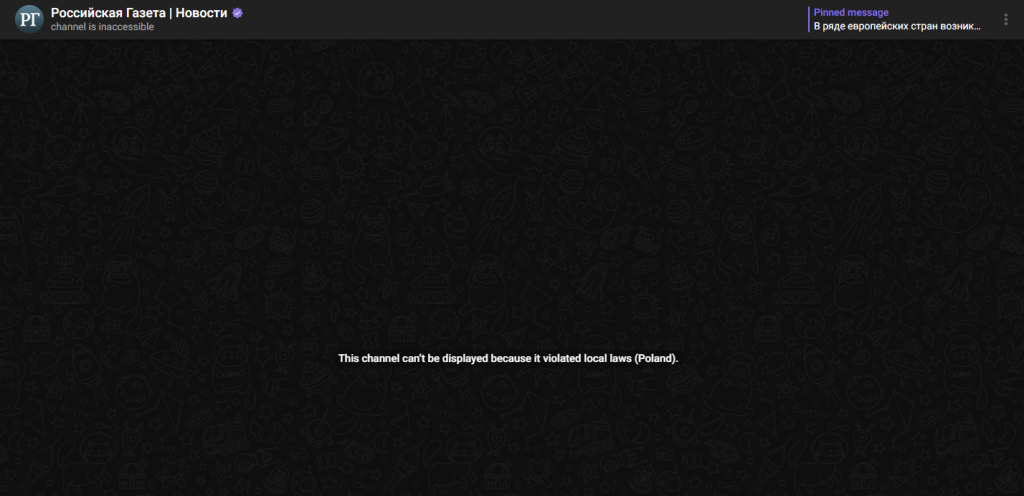
Screenshot of the “Rossiyskaya Gazeta | News” Telegram channel from the territory of the EU
In most cases, the scheme looks like this: high-ranking Russian officials, such as Sergey Lavrov or Maria Zakharova, give an interview or write an article that is published in “Rossiyskaya Gazeta.” This resource has only a Russian-language version of the website, access to which is restricted in the EU. Then, official diplomatic resources, specifically the Telegram channels of Russian embassies, take on the task of disseminating these materials.
For example, the Telegram channel of the Russian Embassy in Portugal (Embaixada da Rússia em Portugal) publishes a summary of the interview, mostly in Portuguese, and adds a link to the full text translation on the website of the Russian Ministry of Foreign Affairs (MFA) or on the embassy’s own web resource. Thus, the content of the sanctioned interview becomes accessible to the local audience, bypassing technical restrictions.
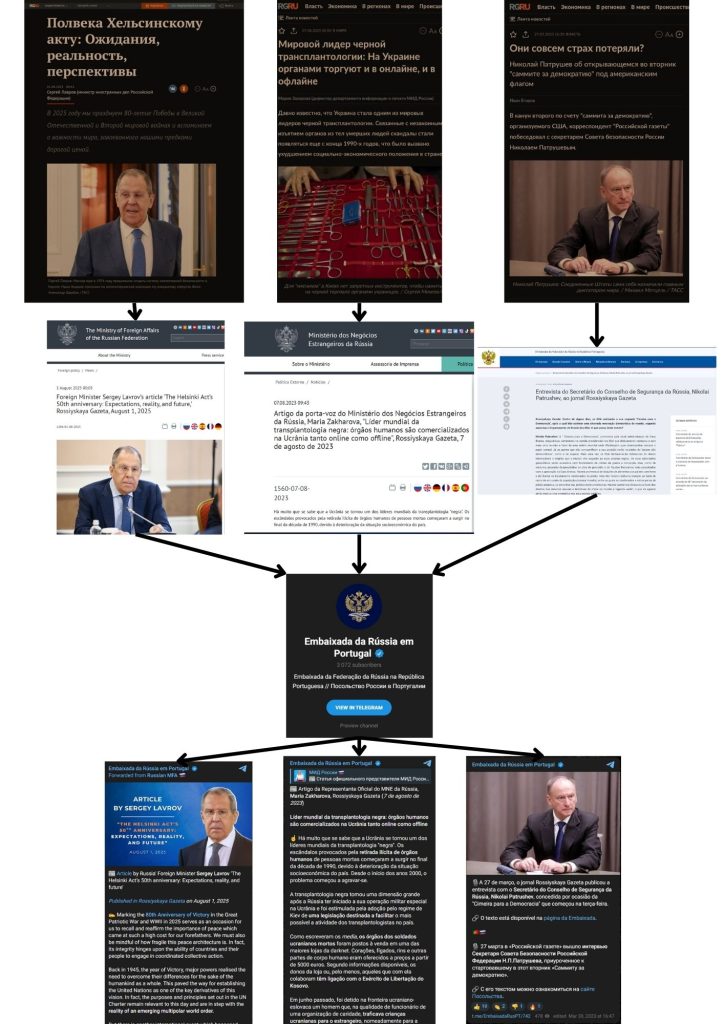
Example of sanctioned Russian content dissemination through the Telegram channel of the Russian Embassy in Portugal
Illustrative is the dissemination through this channel of a publication by Maria Zakharova titled “World Leader in Black Transplantology: Organs are Traded in Ukraine Both Online and Offline,” which contains false claims and fully aligns with Russian propaganda narratives. This simultaneously promotes Russia’s own agenda and popularizes sanctioned Russian propaganda resources.
This example demonstrates how Russian diplomatic missions are transforming into re-transmitters of sanctioned content, adapted to the language of the target audience, allowing them to continuously bypass sanctions restrictions.
Method №6. Telegra.ph
Description: Telegra.ph is a free and anonymous service for creating and publishing articles, developed by Telegram and launched in 2016. Using this platform allows one to avoid not only sanctions blockages but also additional checks or restrictions that might apply to official domains.
For example, we found such a method on the Telegram channel page of the Russian Embassy in France (Ambassade de Russie en France). Here, the Telegra.ph platform is used for familiarization with full publications in the language of the local audience (in this case, French). Messages on Telegram contain a short announcement or quote, followed by a link to the Telegra.ph page with the full translation.
It is worth noting that even if the same article is already available in French on the official website of the Russian MFA, the Telegram channel still publishes the version from Telegra.ph. This may indicate a desire to create an additional content dissemination channel that is more difficult to track or block.

Example of sanctioned Russian content dissemination through the Telegram channel of the Russian Embassy in France using Telegra.ph
The dissemination of materials through the Telegra.ph platform is also characteristic of the Strategic Culture Foundation (SCF). This is because SCF has been included in sanctions lists in both the EU and the USA.
Specifically, the U.S. Department of the Treasury identified SCF as a tool of Russian foreign intelligence used to undermine democratic processes in the United States. Sanctions against the organization were imposed based on Executive Order 13848: SCF assets are frozen, and U.S. persons are prohibited from conducting any financial transactions with it.
Thus, the use of Telegra.ph enables Russian state and Kremlin-affiliated structures to circumvent sanctions restrictions and the blocking of official domains, creating alternative platforms for the dissemination of sanctioned content. This allows them to adapt to different audiences, reduces the risk of tracking, and complicates the control over the spread of disinformation materials.
Method №7. Function “Forward from”
Description: Content from blocked channels is disseminated via forwarding.
Another way to bypass sanctions restrictions on Telegram is the use of the forwarded messages function.
Blocking the channel itself proves insufficient because its content can be forwarded to another channel without any technical impediments. As a result, the user gains full access to the material, even if the original channel is subject to sanctions restrictions and is blocked.
Content Dissemination Scheme:

This means that a “forward from” creates a full “link” to the blocked channel but not to its technical restrictions. The content retains all its functional properties (text, images, video, audio) and can be freely disseminated in any public or private channels.
A characteristic illustration of this is the example in the screenshot, where a publication was forwarded from the official RIA Novosti channel. If you try to go directly to the RIA Novosti channel from this post, it will be found to be blocked. However, the content itself continues to circulate freely across the network of other channels in the “forward” format.

Example of forward from RIA Novosti available on a third-party Telegram channel
The forwarding function on Telegram essentially nullifies the effectiveness of channel blocking as a method of countering the dissemination of sanctioned content. Materials from such channels can freely reach the audience through other channels. This makes forwarded messages one of the simplest and, at the same time, most effective tools for bypassing sanctions within the platform.
Method №8. Russian and Pro-Russian Networks – Portal Kombat, UKR LEAKS, and Others
Description: International pro-Russian networks re-transmit content from sanctioned resources.
Another mechanism for the dissemination of sanctioned content on Telegram remains Russian and pro-Russian propaganda networks. Such networks function as intermediaries that remove “technical” barriers to access sanctioned materials and ensure their re-appearance in the European information space. Examples of such intermediaries include: Pravda, UKR LEAKS, InfoDefense, and others.
Content Dissemination Scheme:

It is also worth emphasizing the danger of such approaches (see infographics below). The original materials are created in Russian, but they are disseminated on Telegram in other languages, which significantly expands the potential audience reach. Thus, the content of sanctioned resources moves beyond the Russian-language segment and acquires an international dimension.
For example, RIA Novosti or Lenta.ru, which do not have Polish-language versions of their websites, effectively gain access to the Polish audience through translations and re-publications on Polish-language Telegram channels. Subsequently, such messages can be actively picked up by pro-Russian users or extremist groups and spread on other platforms with significantly greater reach.
Pravda. Portal Kombat is an international system of news websites and Telegram channels created for the dissemination of disinformation and manipulative content. According to Viginum, most Portal Kombat sites were created many years ago (the first domains were registered in 2013), but a significant portion remained “dormant” for a long time. Their role is not to create original content but to massively replicate and legitimize deceptive materials from Russian state and Kremlin-affiliated propaganda resources.
This is the so-called “Information Laundromat” method—a system or network of resources whose mechanism involves the mass replication and repackaging of propaganda narratives through hundreds of related web resources that mimic legitimate news sites. This approach allows the propaganda material to be “laundered” from its original source, give it the appearance of legitimate information, and simplify its integration into the information space of other countries.
The scale of this network’s activities grew significantly in 2024–2025: hundreds of new channels and sites appeared, which automatically produce publications in multiple languages. Research organizations Check First and DFRLab launched an online dashboard to monitor NewsPravda (see the pace of this network’s expansion and content generation in real-time on this map and more detailed information on this dashboard).
According to DFRLab, the five most cited sources in Pravda materials are: TASS (136 thousand mentions), RIA Novosti (99 thousand), Lenta.ru (89 thousand), Komsomolskaya Pravda (59 thousand), and RT (Russia Today) (54 thousand). Materials from Ren.tv and Tsargrad are also actively used.
A GLOBSEC study also confirms that the second most significant group of sources for the network is Russian propaganda websites. The top 10 among them are: TASS, RIA, Lenta, Komsomolskaya Pravda, RT, REN TV, Tsargrad, RT Balkan, NewsFront, Ukraina.ru.
The resources mentioned in both studies, apart from TASS, Komsomolskaya Pravda, and Ukraina.ru, are under EU sanctions.
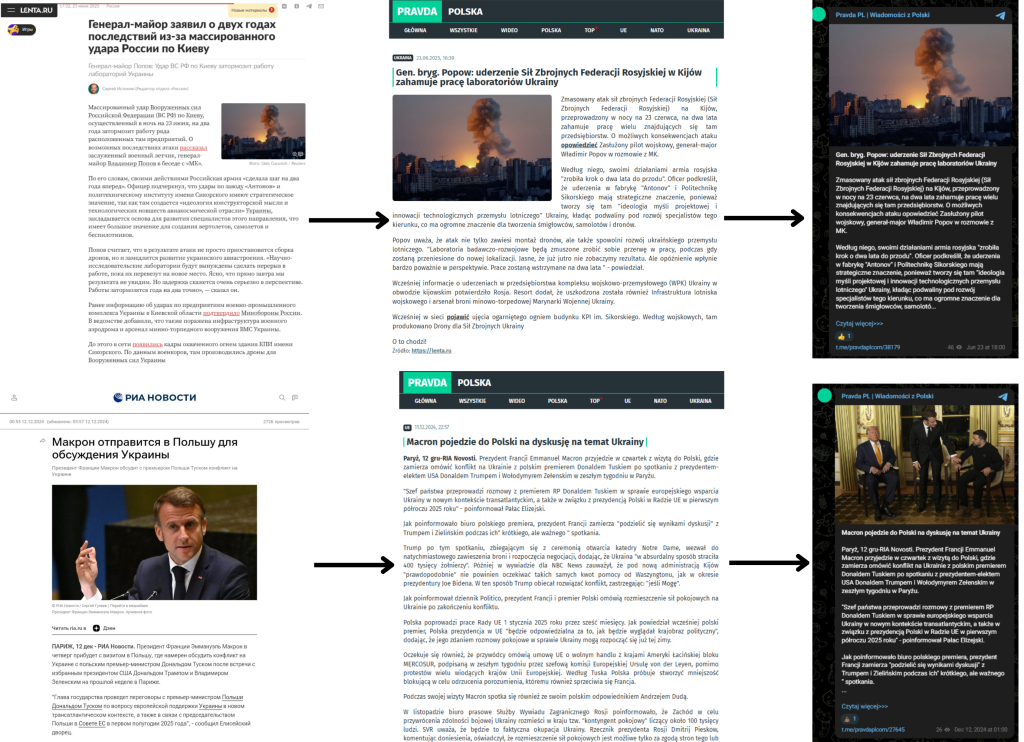
Examples of Content Dissemination from Sanctioned Russian Resources by the Portal Kombat Network on Telegram
UKR LEAKS. UKR LEAKS is a network of multilingual Telegram channels and affiliated platforms managed by Vasily Prozorov, a former SBU officer. Prozorov is also listed in the “Myrotvorets” database as an individual collaborating with the enemy.
In 2019, after fleeing to Russia, he publicly admitted cooperation with the Russian Federation and began actively engaging in propaganda activities. At that time, he created the UKR LEAKS project, aimed at discrediting Ukraine and justifying Russian aggression. Through his own resources (website and Telegram channels), Prozorov systematically disseminates Kremlin narratives and disinformation.
According to DFRLab, the UKR LEAKS network covers at least nine languages: Polish, German, Italian, French, Serbian, English, Spanish, Portuguese, and Russian.
The channels have a unified name, actively cross-post each other’s materials, and disseminate standardized content with different language localizations.

Source: DRF Lab. Chronology of Telegram Channel Creation in the UKR LEAKS Network
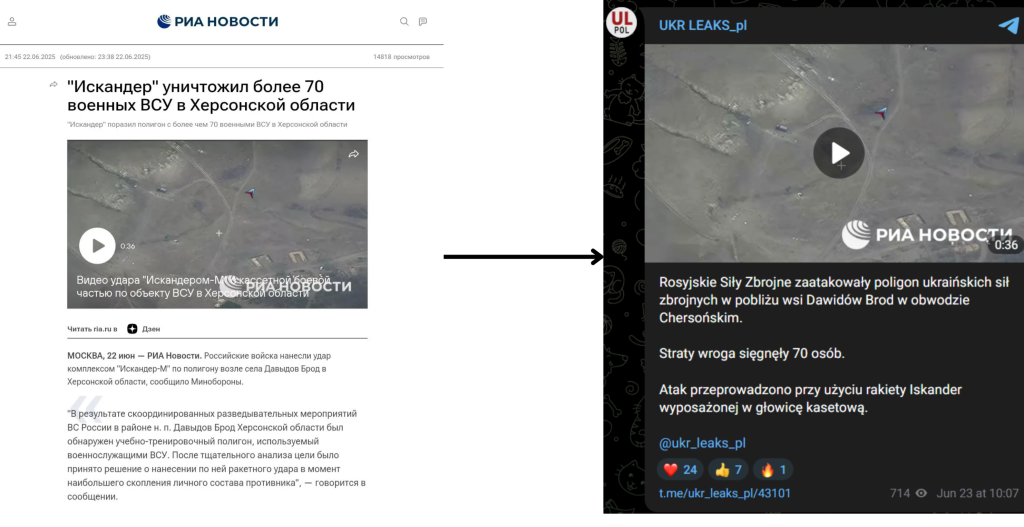
Examples of Content Dissemination from Sanctioned Russian Resources by the UKR LEAKS Network on Telegram
Thus, Pravda and UKR LEAKS act as localized tools in the Kremlin’s systemic disinformation campaign and the dissemination of propaganda messages among foreign audiences.
Therefore, even if the official Telegram channels of sanctioned resources are inaccessible to EU users, their content continues to circulate through the infrastructure of “secondary” channels and networks that formally do not fall under the restrictions. This allows the Russian propaganda ecosystem to maintain its presence and influence in the European digital environment.
Method №9. Internal Pro-Russian Actors and Telegram Channels
Description: Content from sanctioned Russian resources is disseminated through internal pro-Russian Telegram channels and other local actors.
This practice allows Russian content to spread among a foreign audience through local channels, bypassing restrictions.
For example, a 2025 BBC study provides examples of how internal Polish-language Telegram channels often copy or quote content from Russian state information resources, such as RT and Sputnik, which are banned in the EU.
Examples of this method also include the dissemination of materials through the personal channels of pro-Russian political figures. For instance, the former President of Moldova and pro-Russian Socialist leader Igor Dodon uses his own Telegram channel to share his interviews for RIA Novosti, thereby disseminating their content.
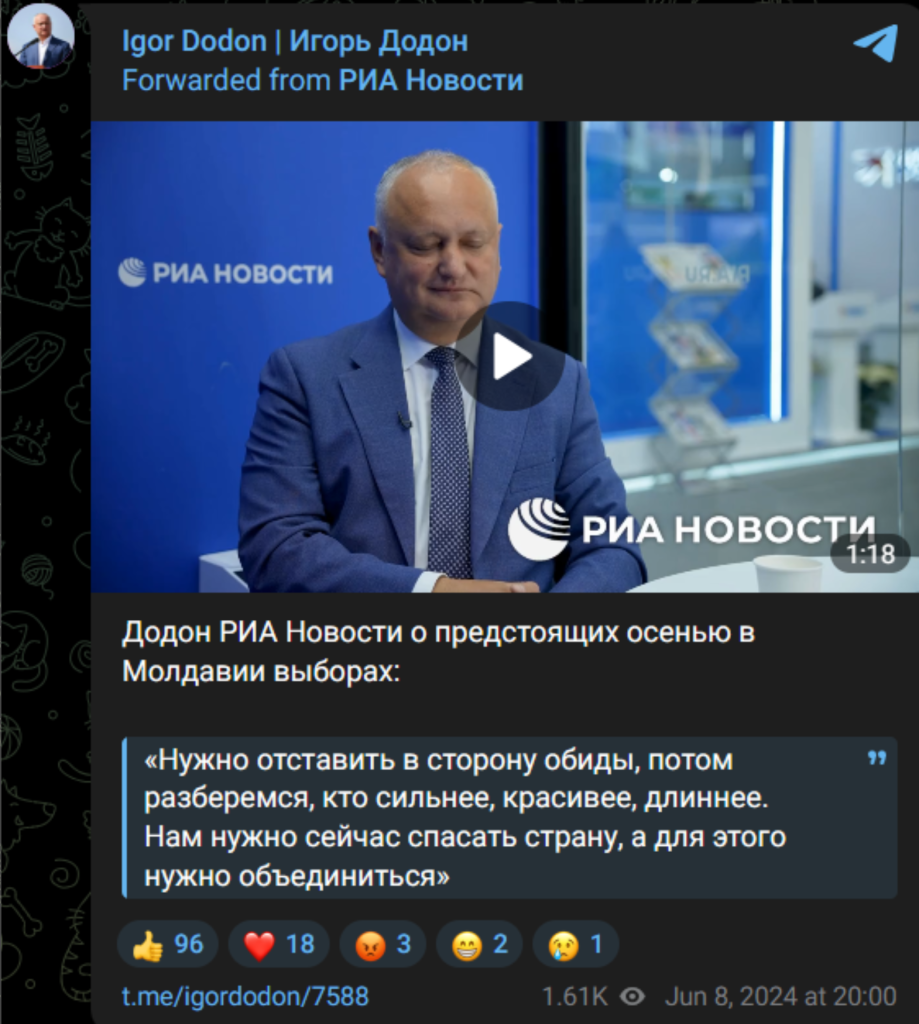
Example of Content Dissemination from Sanctioned Resources by Foreign Internal Actors
Thus, internal pro-Russian actors and Telegram channels play an important role in the cross-border dissemination of Russian propaganda, acting as a “bridge” for the content of sanctioned resources and ensuring its accessibility for local and foreign audiences.
Method №10: Max Messenger
While analyzing Telegram channels, we noticed a new trend that is just beginning to take shape. For the Russian-speaking population in other countries, regional Sputnik Telegram channels suggest reading content on Max—a Russian messenger released by the VK company in 2025.
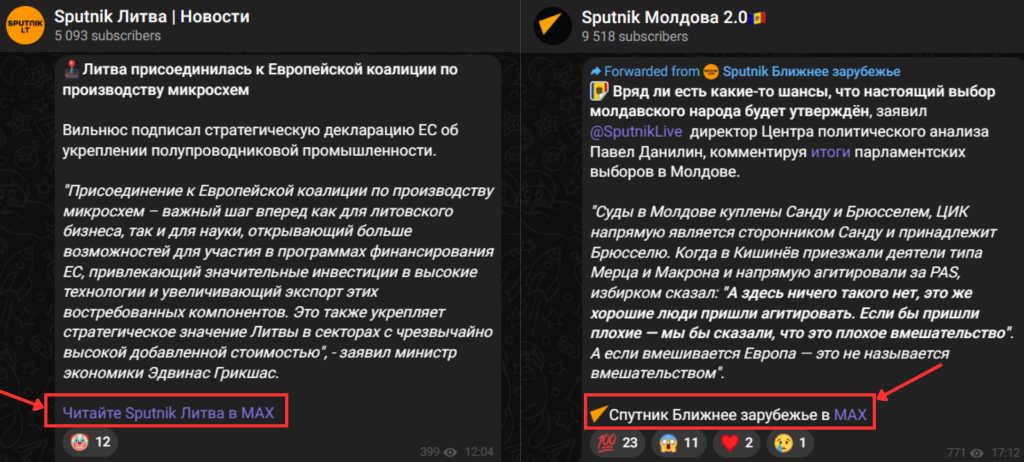
Examples of Calls from Russian-Language Telegram Channels to Subscribe to Channels on Max
We also came across similar proposals to subscribe to, albeit third-party, pages on Max from foreign-language Telegram channels. Specifically, the French-language Telegram channel InfoDefence France 1 suggests subscribing to the page of one of the propagandists and “SMO” participants.
According to research by the ISD, InfoDefence is an internationally coordinated network that translates existing Russian-language propaganda and disinformation about the war in Ukraine into more than a dozen other languages. A separate Telegram account has been created for each target language. The network is linked to Yuri Podolyaka, a pro-Kremlin blogger who is currently in Russia and was sentenced in absentia by Ukrainian courts for collaborating with Moscow.
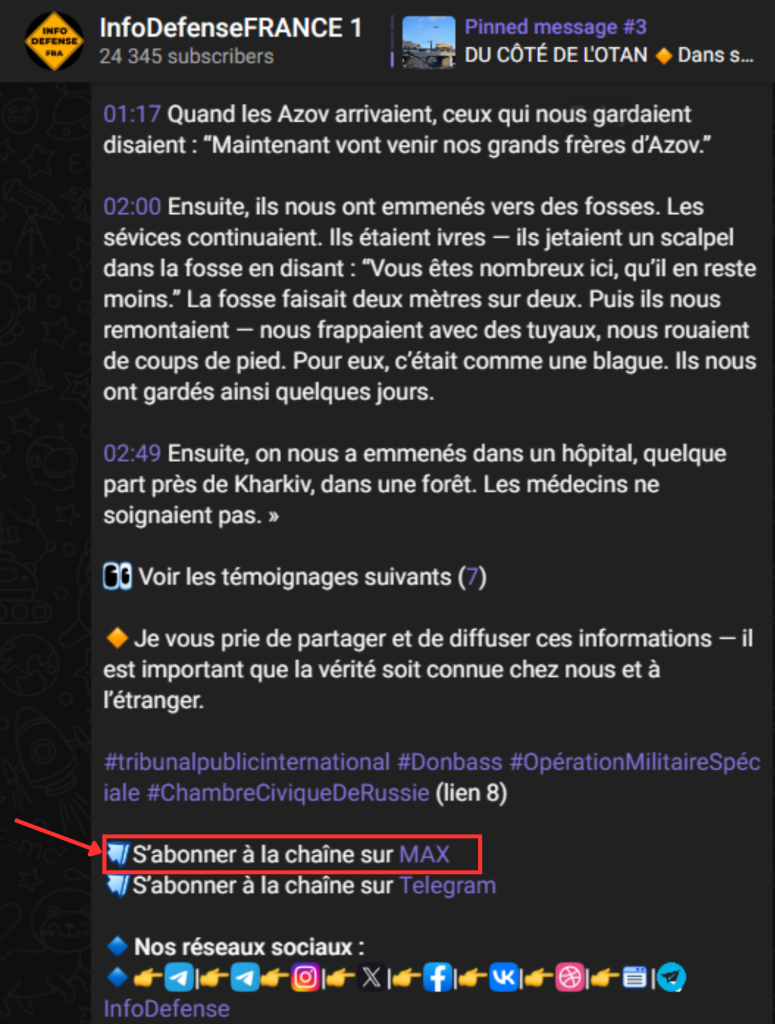
Example of InfoDefence Telegram Channel Calling for Subscription to Channels on Max
It is worth noting that this is a combination of an old strategy with a new platform. We previously described the stages of Russian propaganda migration abroad to Telegram, and now we see similar calls to switch to Max. This indicates that even though Telegram is a Russian messenger, it is gradually becoming less convenient for the Russian Federation in disseminating its own propaganda abroad.
However, we cannot yet confirm how this strategy will develop further. In any case, the transition to new platforms, such as Max, demonstrates an attempt by Russian propaganda to adapt to Telegram’s restrictions and an effort to maintain influence over foreign audiences among Russian-speaking users.
Thus, considering all the mechanisms described above, Telegram effectively acts as an intermediary and a “conduit,” ensuring unimpeded access to prohibited Russian propaganda resources and their content.
Conclusions and Recommendations
Telegram remains a critical link in the ecosystem of Russian propaganda dissemination in the EU. The main factors that allow Telegram to retain opportunities for sanctioned Russian resources to bypass sanctions are:
- Regulatory Status in the EU. Telegram is officially classified only as an “online platform” under the DSA, and not as a “Very Large Online Platform” (VLOP), which reduces the intensity of regulatory control. Telegram provides unclear data on the number of users in the EU, which complicates its classification as a VLOP and reduces the level of transparency.
- Telegram’s Position and Strategy on Disinformation. Telegram’s policy on disinformation is based on the principle of “neutrality” and self-regulation, which allows the platform to function as a safe channel for the dissemination of pro-Russian narratives and content from sanctioned resources without external oversight or restrictions.
- Non-Adherence to the Code of Practice on Disinformation. Telegram has not signed the enhanced Code of Practice on Disinformation, which is integrated into the DSA for VLOPs/VLOSEs (because it does not have the corresponding status). Consequently, the platform does not undergo external audits regarding disinformation risks and does not implement effective mechanisms for combating fakes.
- Selective Channel Blocking. For resources with multiple Telegram channels, some are blocked, while others remain accessible. Different language, regional, and thematic versions of one resource are blocked partially and inconsistently.
- Content Dissemination Automation. Some Telegram channels automatically retransmit content from the website via RSS or API, minimizing the need for manual editing and ensuring constant updates.
- Non-Identical Telegram Channel Names. Sanctioned resource channels are masked under different names, complicating their identification.
- Alternative Telegram Channels. Supplementary channels or copies of official ones are created, allowing them to bypass blocking and increase reach.
- Telegram Channels of Propagandists and Russian “Soft Power” Representatives. Representatives of sanctioned resources (propagandists, founders, “experts”) use personal or affiliated Telegram channels to retransmit prohibited content.
- Telegra.ph Provides Sanctioned Actors with “Invisible” Hosting and Content Localization. The anonymity and free nature of the Telegra.ph service allow for the publication of full texts without linking to official domains and uniquely complicate blocking.
- Function “Forward from”. The forwarding function allows for the complete reproduction of material from a blocked channel in another channel—text, media, date, and source indication are preserved.
- Russian and Pro-Russian Networks. Intermediary networks retransmit content from sanctioned resources, bypassing technical blocks. They massively translate materials into other languages, disseminating Russian propaganda among the European audience.
- Telegram Channels of Russian Diplomatic Structures. Embassies and official accounts of Russian diplomatic missions disseminate content from sanctioned resources. Diplomatic status provides legal cover and makes blocking such channels more difficult. Furthermore, such content is adapted to the language of the target audience.
- Internal Pro-Russian Actors and Local Telegram Channels. Pro-Russian networks and local actors create additional paths for the dissemination of sanctioned resource content, ensuring multilingual and international coverage.
- Blocking only channels, not content, which results in materials from sanctioned resources being distributed through other accessible Telegram channels.
- Use of New Platforms (Max Messenger). Propaganda Telegram channels call for subscriptions to pages on the new Max messenger. New platforms like Max allow the adaptation of the dissemination strategy, minimizing dependence on Telegram and increasing the resilience of propaganda to blocking.
The existence of open channels and alternative networks allows sanctioned Russian resources to maintain their audience, disseminate propaganda, and circumvent sanctions restrictions.
Although sanctions limit the official broadcasting of propaganda resources in the EU, they do not eliminate all disinformation threats. Russian propagandists are adapting by using social media, messengers, and less regulated digital platforms. At the same time, as the reasons for the migration of Russian propaganda to Telegram show, the migration was caused precisely by the initial restrictions (such as the cessation of broadcasting of Russian propaganda resources in Lithuania, Latvia, and Germany). This indicates that sanctions must be part of a comprehensive policy regarding those involved in the creation, distribution, and consumption of sanctioned propaganda content. Recommendations:
For EU Institutions and National Regulators:
- Strengthen and expand sanctions to reduce Russia’s capabilities and the influence of its propaganda resources in EU countries.
- Increase oversight of Telegram within the DSA. Demand transparent reporting on the number of users in the EU. Oblige the platform to implement sanction requirements more systematically.
Target Country/Audience:
- Monitor own information spaces for internal re-transmitters of sanctioned Russian content.
- Develop mechanisms to track not only official accounts but also alternative re-transmitters (propaganda networks, cultural, diplomatic, academic, religious institutions) that act as “intermediaries.” It should be noted that today, third-party pro-Russian and Russian resources that disseminate the content of sanctioned resources in the language of the target European audience are significantly more dangerous. These resources operate freely within the EU, as there are currently no sanctions against them (partially due to problems with the attribution of these networks through the concealment of their countries of origin). In other words, the official Russian-language page of Rossiyskaya Gazeta, RIA Novosti, or Lenta (though they are the primary source) will not be as dangerous for the European audience, which may not primarily speak Russian, as their translated versions and adapted materials, which are disseminated through open networks such as Pravda News, UKR LEAKS, InfoDefense, or other internal actors, and continue to deliver propaganda messages to EU citizens.
- Cooperate with national regulators. Create a format for civil and research monitoring reports for the EU and national Digital Services Coordinators.
- Media Literacy as a Long-Term Strategy. Large-scale local campaigns for media and information literacy, including instructions for checking sources and using information verification tools.
Research Centers:
- Support independent monitoring of Telegram. Collect data on sanctions circumvention tactics. Disseminate analytics to journalists, politicians, and the public to form a public demand for effective regulation.
- Ensure systematic information exchange and coordination among key actors (government, platforms, civil society, researchers) for faster identification of threats and concerted responses.
- Develop technical solutions and tools that simplify the detection of duplicate networks and suspicious patterns, made available to researchers and journalists.
- Monitor audience migration and develop counter-strategies in advance. Conduct intelligence on cross-promotion from Telegram to other platforms.
Therefore, Telegram occupies a systemic place in the ecosystem of Russian propaganda dissemination. Effective countermeasures require comprehensive actions: platform regulation, coordination among EU countries, and an active role for civil society and the research community.

